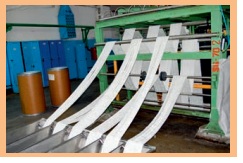Polymer Chemistry | Term 3 Unit 3 | 7th Science - Characteristics, Advantages, Drawbacks of Synthetic Fibres | 7th Science : Term 3 Unit 3 : Polymer Chemistry
Chapter: 7th Science : Term 3 Unit 3 : Polymer Chemistry
Characteristics, Advantages, Drawbacks of Synthetic Fibres
Characteristics, Advantages,
Drawbacks of Synthetic Fibres
Characteristics of Synthetic Fibres
ACTIVITY 5
Burning A Piece of
natural fibre and a synthetic Fibre
Note: This activity should
be performedonly by the teacher.
Take a piece of cotton
cloth and a piece of polyester cloth. Both the pieces of cloth can be of same
size (2cm x 2cm is enough). Hold the pieces of cloth using tongsto protect
yourself from the flame and heat. Burn both the pieces of cloth one by one and
see what happens when they burn.
What do you observe
while the cotton cloth burns?
Answer: The
cotton cloth burns completely. Does not melt and has the odour of burning
paper.
What do you observe
while the polyester cloth burns?
Answer: Polyester
cloth melts on burning and giving off black smoke.
You must have noticed
that natural (cotton) fibresburn very differentlycompared tosynthetic
(polyester) fibres.

The cotton cloth will
burn when it is held in flame. On the other hand, the synthetic polyester cloth
will melt on burning. This is one of the disadvantages of wearing clothes
madeout of synthetic fibres. If a synthetic cloth comes into contact with fire
the fabric melts and sticks to the body causing severe burns. Therefore, one
should not wear synthetic clothes while cooking or working in a laboratory.
ACTIVITY 6
Wetting A Cotton Cloth
And An Umbrella Cloth
We use an umbrella on
rainy days. What kind of umbrella do we use?
Answer: Nylon
or Polyester
Can you use an
umbrella made of cotton?
Let us do an activity to see why we do not use a cotton umbrella to protect ourselves from the rain. Take a piece of cotton cloth of approximately 10 cm X 10 cm size and a piece of nylon or polyester cloth 10 cm X 10 cm in size from an old unusable / untorn umbrella. Ask four students to hold the four corners of the piece of cotton cloth and pour a glass of water over it. Then ask four students to hold the piece of umbrella cloth and pour a glass of water over it. Compare the effect of water on the piece of cotton cloth and umbrella cloth and record your observation in the notebook.
Which of these fabrics
allows water to pass through?
Answer: Cotton
cloth allows water to pass through whereas umbrella cloth does not allow water
to pass through.
Cotton cloth or Umbrella cloth (nylon or polyester) Now ask the students to put both the pieces of cloth in the hot sun to dry. Which of these fabrics dries the fastest? The cotton cloth or the umbrella cloth?
Answer: Umbrella cloth dries the fastest.
Synthetic fibres are made from the byproducts of processing petroleum
oil and gas. You will learn about fractional distillation of petroleum in your
higher classes.

Advantages of Synthetic Fibres
Do you ever think about why some of
your clothing does not need ironing and looks bright and colourful for many
years? This is because they are made from synthetic fibres such as polyester
and the advantages are that they do not wrinkle easily and they keep their
colour and brightness for a much longer time than natural fibres such as
cotton.
A lot of materials such as fishing nets are made from synthetic fibres. One of the main advantages of using synthetic fibres such as nylon, is that they are stronger than many natural fibres such as silk or wool. For example a trampoline is made of woven synthetic fibres. These fibres are strong and elastic which gives it the properties to bounce.
Drawbacks of Synthetic Fibres
We have already learned that it is
safer to use cotton clothing instead of synthetic clothing when a person is
cooking or working in a laboratory. This is because one disadvantage of synthetic
fibres such as polyester is that they are not heat resistant and catch fire
easily. In summer it is better to wear clothing that is made out of cotton
materials rather than synthetic.
This is because most synthetic
fibres absorb very little moisture and do not allow air circulation making them
hot and uncomfortable to wear.
If you could recall that we already
found out that synthetic fibres are made out of petrochemicals and last in the
environment for a very long time. The disadvantage is that they break down into
very small pieces called microplastics which cause pollution to soil and water bodies such
as rivers, lakes and oceans.
Related Topics